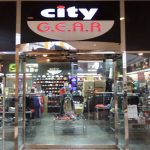G-III Apparel Group Ltd. reported first-quarter earnings exceeded guidance and reiterated its outlook for the year. Shares, however, fell about 10 percent as sales in the quarter missed guidance and officials warned of a further deteriorating retail business and tariff uncertainties.
Shares of G-III Apparel fell $2.54, or 9.4 percent, to $24.51 Wednesday on the New York Stock Exchange.
In contrast to many other vendors indicating they’ve either reduced or plan to reduce their exposure to China sourcing, Morris Goldfarb, G-III Apparel’s chairman and CEO, said on his company’s quarterly conference call that G-III is apprehensive about “radically” leaving factory partners in China due to concerns over quality.
He noted that some of its relationships with factories last 30 to 40 years.
“We are not choosing factories or countries solely on the merit of tariff,” said Goldfarb. “We have great product. We work hard at developing these relationships. We are not very fast to give them up.”
He said that so far, the company has been impacted in the handbags area with tariffs on those goods increasing to 25 percent from 10 percent on May 10. Handbags accounted for approximately 7 percent of G-III’s annual net sales for fiscal 2019. The incremental 15 percent increase in tariffs for the remainder of fiscal 2020 is expected to increase costs by approximately $6 million and that is included in its reaffirmed EPS guidance.
G-III has been seeking to move some production out of China, obtaining price concessions from Chinese factories and has obtained price increases from some retail customers in the U.S. to help offset the cost impact on handbags.
On the potential tariffs on the fourth list of goods that will include apparel and footwear, Goldfarb said the company has “had in depth conversation with our vendors and our retailers and although there’ll likely be short term disruption, all parties are willing to share in the increased cost.”
Goldfarb said G-III hasn’t quantified the impact of these tariffs but also expects the consumer “is willing to pay more” for its power brands: DKNY, Donna Karan, Calvin Klein, Tommy Hilfiger and Karl Lagerfeld.
“This price increases will be supported by the fact that we have the best global power brands, well designed products at the highest quality, better real estate positioning in the stores and our always price better than our competition,” said Goldfarb. “Looking ahead, we recognize the need to further reduce our production in China to a level where we can still maintain the consistent high quality and craftsmanship that we have developed with our vendors over the past 40 years.”
In the quarter ended April 30, earnings improved 21.8 percent to $12.0 million, or 24 cents a share, from $9.9 million, or 20 cents, a year ago. On a non-GAAP basis that excludes the impact of non-cash and period interest and a gain on lease terminations, earnings improved to 25 cents a share from 22 cents and topped Street estimates of 22 cents. Guidance had called for adjusted EPS in the range of 15 to 25 cents.
Goldfarb said the performance was “led by continued outperformance in our wholesale business which more than offset the challenges in our own retail operations.”
Revenues improved 3.6 percent to $633.6 million, falling short of guidance of $650.0 million.
Goldfarb said the revenue shortfall was due to misses at its team license business and Kensie. The team licensed business includes Touch by Alyssa Milano, Hands High, Starter, GIII for Her and GIII Sports by Carl Banks.
Net sales of its wholesale operations segment increased 8 percent to $571 million, driven mainly by Tommy Hilfiger and DKNY. Strength was also seen by Calvin Klein while Karl Lagerfeld had a small increase. The overall growth rate at wholesale was held back by sales of Bon Ton in the first quarter of last year.
Net sales at the retail operations segment for the quarter were $82 million, approximately 22 percent lower compared to last year sales and negatively affected by the decrease of approximately 60 stores compared to the first quarter of last year. Same-store sales decreased 23 percent for Wilsons stores, 11 percent at G.H. Bass and 1 percent for DKNY. G-III now anticipates non-GAAP losses in its retail operations segment in fiscal 2020 will be similar to fiscal 2019.
Gross margin percentage in the quarter was 37.3 percent, down from 38.3 percent in the prior year’s period. Gross margins at wholesale operations were 34.9 percent compared to 35.2 percent in the previous year’s quarter. The gross margin percentage in retail operations was 45.2 percent compared to 46.3, mostly as a result of higher promotions at Wilsons. SG&A expenses were flat at $202 million.
G-III maintained its outlook for the year due to the outperformance and healthy orders for its primary wholesale brands.
Revenues for the year are expected to be $3.28 billion and net income between $163 million and $168 million, or $3.19 and $3.29 per share. Non-GAAP net earnings are expected between $167 million and $172 million, or between $3.25 and $3.35 per share. Adjusted EBITDA is expected between $307 million and $313 million compared to adjusted EBITDA of $269.4 million in fiscal 2019.
For the second quarter ending July 31, sales are expected to reach $660.0 million and net income between $8.0 million and $13.0 million, or 15 to 25 cents. This compares to sales of $624.7 million and net income of $10.1 million, or 20 cents, in the year-ago quarter. Non-GAAP earnings are expected between 17 cents and 27 cents compared to 22 cents.
Photo courtesy DKNY
















